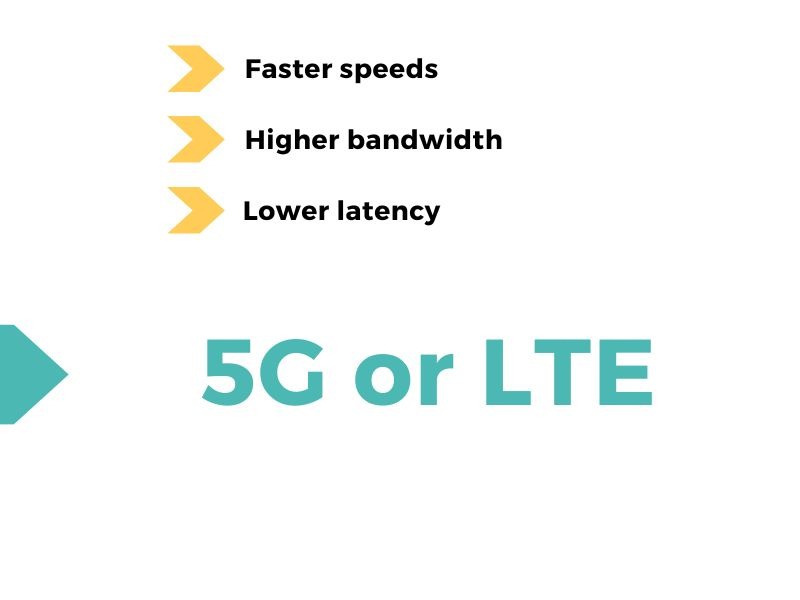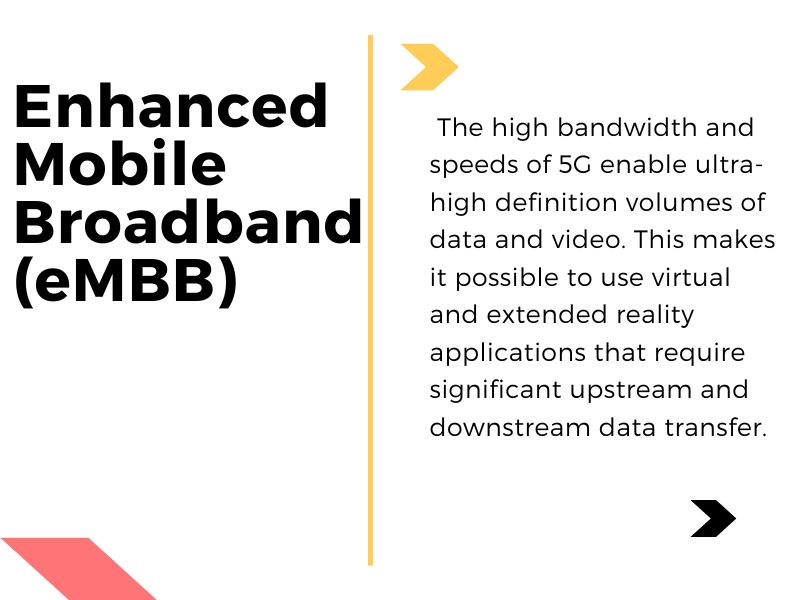LTE Or 5G – Let’s Explore The Key Differences With Techie Prey

The world today is very different from that of twenty years ago. Economies, industries, and businesses have evolved digitally, and with this evolution has come a need for improved connectivity and wireless communication. This Digital Transformation has had a significant impact on the Telecommunications sector and the specific demand for faster and more efficient network offerings. This has led to the adoption of various wireless networking technologies such as “Long-Term Evolution” (LTE) and, more recently, the deployment of 5G. Below we look at these two networks in more detail and answer the question “How are they different and what do they offer the world?”
An Introduction to LTE and 5G
To understand the value and differences between these wireless communications, it is important to define them.
Simply put, LTE is a fourth-generation network, often referred to as LTE 4G wireless. The 4G LTE standard is now considered obsolete, and more modern 4G networks are based on advanced LTE technology called LTE-Advanced. Thus, LTE-Advanced is an evolved version of the old LTE.
Over the past two decades, this 4G LTE network has increased the capacity and speed of networks for mobile devices compared to what the Third Generation 3G network offered. LTE has several different characteristics, including:
- Streaming Audio and Video – LTE offers faster download and upload speeds than 2G and 3G.
Real-time connection to services – Voiceover over LTE allows users to talk to other people without any delay. - Carrier Aggregation – LTE-Advanced technology improves network capacity by adding bandwidth of up to 100 MHz across five component carriers (bands) each having a bandwidth of 20 MHz.
As Digital Transformation has revolutionized industries, the need for even greater network capacity has arisen. This is why the 5G network was deployed. 5G is the fifth generation of wireless technology. It offers increased speed, reduced latency, and improved reliability.
5G Faster Than 4G
Not only is 5G faster than 4G, but it is also much more secure and stable than older networks. 5G allows data to go from one place to another with a much shorter delay between submission and arrival. This process is known as latency.
The International Telecommunications Union recently released several statistics highlighting the difference between LTE and 5G. According to their findings, 5G networks aim to provide:
- Mobile data volume per area is 1000 times higher
- 100 times more connected devices
- 100x higher user data throughput
- Ten times longer battery life for low-power communications of massive machines
- Five times less end-to-end latency
It is clear from the above that 5G offers more connectivity, so much so that GMSA recently stated in its 2023 Mobile Money Report that 5G will overtake 4G in 2029 to become the dominant mobile technology. According to this report, as of January 2023, there are 229 commercial 5G networks worldwide, and more than 700 5G smartphone models have been launched.
It is essential to mention that 4G LTE networks will continue to be used worldwide, especially as connections from legacy networks (2G and 3G) continue to be migrated to 4G and 5G LTE networks.
Therefore, both LTE and 5G have their place in today’s world, as they offer several benefits to industries, businesses, and consumers. Below we look in more detail at how these wireless communications networks work.

The Difference Between LTE And 5G
It’s easy to identify the main differences between 5G and LTE. LTE is a broadband wireless communications standard that has been around since 2009, while 5G, or fifth-generation networking, is the new wireless standard, currently being rolled out.
Comparing the two networks side by side, we can highlight the following differences:
- LTE vs. 5G Speed: LTE offers speeds of up to 100 Mbps, while 5G can offer speeds of up to 1Gbps.
- LTE vs 5G coverage: LTE has extensive coverage, while 5G is still in the early stages of deployment.
- LTE vs 5G Capacity: LTE can support up to 1,000 devices per cell, while 5G can support up to 10,000 devices per cell.
Thus 5G offers greater speed, coverage, and capacity than LTE. With this comes access to greater spectrum at higher frequencies. This means that networks will be able to support more high-demand applications simultaneously and provide a fiber-like experience for fixed wireless applications. This will particularly benefit people in areas that do not have effective connectivity.
Powerful Network 5G
5G also has several other deployments that make it powerful. These include:
- Enhanced Mobile Broadband (eMBB) – The high bandwidth and speeds of 5G enable ultra-high definition volumes of data and video. This makes it possible to use virtual and extended reality applications that require significant upstream and downstream data transfer.
- Massive Internet of Things (mIoT) – Enhanced connectivity, up to 1 million connections per square kilometer, is essential for implementing advanced massive IoT applications.
- Private Wireless – A private 5G network supports indoor and outdoor operations without the impact of traditional and ad hoc wireless designs while supporting and securing critical business operations.
- Network Slicing – A network slice is useful for large networks. It allows a Telecommunications Operator to create a connectivity solution adapted to a customer, who can thus obtain a “slice” of the public network adapted to their specific needs.
Advantages Of 5G Deployment
Although the deployment of 5G has several advantages, it also poses certain problems compared to the LTE network. For 5G services to work effectively, Telecommunications must use a combination of different frequency bands. This plays a vital role in the speed and scope of coverage.
For 5G applications, such as video on demand (VAD) and autonomous vehicles, to work, telecommunications companies need access to large amounts of spectrum. The problem is that spectrum is a scarce resource. This means that telecom companies overall must use a mix of low-band, mid-band, and high-band spectrum to deliver the 5G user experience that customers expect.
Commercial Operators such as the GSMA recommend that regulators and government agencies that control the allocation of 5G spectrum make available 80 to 100 MHz of contiguous spectrum per operator in the core 5G bands and approximately 1 GHz of spectrum per operator in millimeter wave bands. This challenge will continue to impact the deployment and delivery of 5G globally.
Strategic Implications for Businesses
It is clear from the above that LTE has played an important role in Digital Transformation and has been associated with the creation of the “app economy”. This term specifically refers to the smartphone and tablet revolution and the deployment of mobile applications in everything from banking to retail, entertainment, etc. These mobile applications relied heavily on LTE and its evolution in connectivity to function.
LTE has created a dynamic shift across multiple verticals, and we can expect 5G to have an even greater impact. The higher bandwidth, near real-time responses, IoT, and mission-critical products and applications enabled by 5G will change how businesses operate, business models, and how entire industries conduct business. Using these technologies, businesses can improve productivity, reduce costs, increase economic output, and optimize customer service.
Benefits Of 5G
One of the most beneficial consequences for businesses will be the speed of data- and insight-driven decision-making that 5G will make possible.
5G will enable the following across all industries:
- Manufacturing – The increased flexibility, visibility, and security that 5G offers will enable the development of configurable factories, mobile robots, and time-sensitive networks, resulting in increased productivity and reduced operational costs.
- Automotive – 5G can improve transportation safety, especially with automated vehicles. It also provides wider bandwidth and edge computing power to enable vehicle-to-infrastructure (V2I), vehicle-to-network (V2N) services, and machine-to-machine (M2M) feedback loops.
- Retail – 5G will reinvent the shopping experience using technologies such as virtual reality (VR) in the metaverse.
- Health – Thanks to the processing of large quantities of medical data and low latency, 5G will make it possible to offer efficient, reliable, and quality home care in the medical field.
- Utilities – 5G can improve worker productivity and safety and asset management through real-time data monitoring and risk mitigation. It can also serve as a basis for network modernization and resilience, operational cost optimization, and asset monetization.
- Education – 5G can create more interactive and connected classrooms through Augmented Reality (AR) and better access to resources to improve accessibility.
To Look Forward
According to what has been said above, 5G is set to change industries as we know them. While there is a lot of excitement around 5G, it is worth noting that many emerging and developing markets still need to catch up when it comes to 5G deployment. This is mainly due to the need for additional infrastructure and investment.
Many telecommunications companies around the world are continually striving to focus their efforts on expanding their fixed wireless access offerings to new areas to provide 5G access in these markets. In doing so, these telecommunications companies continue to sell the adoption of smartphones and other digital services.
The global rollout of 5G has also led to a lot of discussion in the metaverse. It is a collective, virtual, and open space, developed by integrating digital and physical reality virtually to offer an immersive experience to customers. Over the next few years, the metaverse will continue to gain traction, primarily because it offers telecommunications companies an innovative way to create new revenue streams.
Benefits of LTE
The introduction of 5G has made many people wonder when 4G will be phased out. 4G LTE has many advantages that will allow it to continue working well after 5G becomes widespread, so 4G LTE and 5G are expected to co-exist for at least a decade. Is 5G better than 4G? Yes, 5G is better in many ways, but 5G networks don’t yet have the coverage to exist on their own without the backbone of the 4G LTE network and everything it provides.
Additionally, today’s 5G devices only cover the high-end and high-speed part of the 5G vision, with mid- and low-end devices expected to follow in the coming years.
Here are some key benefits of LTE:
- Cheap radio: 100 Mbps or more is too much for simple radio applications, which can operate adequately at 3G performance levels. Using the low frequencies of the LTE network allows a wide range of products to operate more cost-effectively.
- Wide coverage for IoT: 4G LTE network availability is almost universal in most countries around the world. For the majority of wireless IoT deployments, reasonably priced network access is a critical part of any application’s business case.
- Mobile video: Previously, 3G allowed videos to be played on the go, but with low resolution and frequent buffering, making for a poor user experience. The superior performance of LTE compared to 3G is responsible for consistently delivering high-quality mobile videos.
The Future of LTE
The future of 4G LTE is still bright. Some 5G capabilities have yet to be available and will not be immediately needed for existing applications that work well with the bandwidth and latency offered by 4G LTE networks. 4G LTE devices will continue to work and can often wait to be upgraded to 5G. Finally, private LTE networks based on CBRS enable many new use cases for 4G LTE today.
Since 4G LTE and 5G share spectrum and 5G devices offer failover to 4G in areas where 5G is not yet established, the migration from LTE to 5G will occur over a while. a decade or more.
Conclusion
There is no doubt that LTE is having a significant impact on industry verticals in terms of improving connectivity. This network brought speed, reliability, security, privacy, and bandwidth. However, with evolution comes even more, and this is where 5G and its networking capabilities steal the show. The evolution of the cellular network has seen 5G change the way businesses operate and provide significant opportunities for innovation. As we continue to use LTE and adopt 5G, the sky is the limit for what is possible in business. So this is an exciting space to consider.




